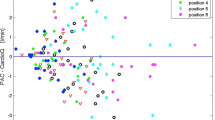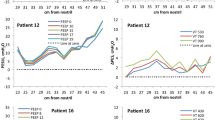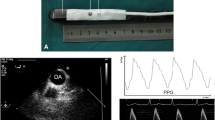Abstract
Background
The Cardio QP™ oesophageal Doppler monitor measures the velocity time integral of the blood flow in the descending aorta. Based on system integrated normograms of the aortic cross-sectional area of a paediatric population, the cardiac output is calculated and displayed.
Objective
Evaluation of the capability of the Cardio QP™ to detect changes in cardiac output during desynchronizing ventricular pacing (VVI) in children after cardiac surgery.
Patients
Eleven children (6 female, 5 male) with epicardial pacemaker electrodes admitted to the paediatric intensive care unit (PICU) after corrective surgery for congenital heart defects. Mean age: 6.3 (2.1–15.0) months, mean body weight: 5.3 (3.5–7.8) kg.
Interventions
After baseline measurements of cardiac output (base I), we performed 3 steps, each lasting 5 min: (1) ventricular pacing (VVI), (2) baseline (base II) recording, (3) atrial pacing (AOO). We measured the effects on haemodynamic parameters and blood gases as well as on the measured cardiac output.
Results
Ventricular pacing, with atrio-ventricular dyssynchrony, led to a significant drop in blood pressure and central venous saturation. Cardiac output parameters showed a decrease in stroke volume (SV) from 4.9±2.2 to 4.2±2.1 ml (P = 0.005) and cardiac index (CI) (2.6±1.1–2.1±0.8 ml/min/m2) (P = 0.009) during ventricular pacing. Cardiac index and haemodynamic parameters during atrial stimulation did not show significant changes from baseline.
Conclusion
The Cardio QP™ seems to be capable of detecting slight changes in cardiac output.
Similar content being viewed by others
Abbreviations
- CHD:
-
Congenital heart defects
- CI:
-
Cardiac index
- CO:
-
Cardiac output
- SD:
-
Stroke distance
- SV:
-
Stroke volume
- TED:
-
Transoesophageal Doppler
- VTI:
-
Velocity time integral
References
Estagnasie P, Djedaini K, Mier L, Coste F, Dreyfuss D. Measurement of cardiac output by transesophageal echocardiography in mechanically ventilated patients. Comparison with thermodilution. Intensive Care Med. 1997;23:753–9.
Kim JJ, Dreyer WJ, Chang AC, Breinholt JP 3rd, Grifka RG. Arterial pulse wave analysis: An accurate means of determining cardiac output in children. Pediatr Crit Care Med. 2006;7:532–5.
Tibby SM, Murdoch IA. Measurement of cardiac output and tissue perfusion. Curr Opin Pediatr. 2002;14:303–9.
Bearss MG, Yonutas DN, Allen WT. A complication with thermodilution cardiac outputs in centrally-placed pulmonary artery catheters. Chest. 1982;81:527.
Bossert T, Schmitt DV, Mohr FW. Pulmonary artery rupture–fatal complication of catheter examination (thermodilution catheter). Z Kardiol. 2000;89:54.
Egan JR, Festa M, Cole AD, Nunn GR, Gillis J, Winlaw DS. Clinical assessment of cardiac performance in infants and children following cardiac surgery. Intensive Care Med. 2005;31:568–73.
Tomaske M, Knirsch W, Kretschmar O, etal. Cardiac output measurement in children: comparison of Aesculon cardiac output monitor and thermodilution. Br J Anaesth. 2008;100:517–20.
Reisner AT, Xu D, Ryan KL, Convertino VA, Rickards CA, Mukkamala R. Monitoring non-invasive cardiac output and stroke volume during experimental human hypovolaemia and resuscitation. Br J Anaesth. 2011;106:23–30.
Botte A, Leclerc F, Riou Y, etal. Evaluation of a noninvasive cardiac output monitor in mechanically ventilated children. Pediatr Crit Care Med. 2006;7:231–6.
Ehlers KC, Mylrea KC, Waterson CK, Calkins JM. Cardiac output measurements. A review of current techniques and research. Ann Biomed Eng. 1986;14:219–39.
Shoemaker WC, Wo CC, Chien LC, etal. Evaluation of invasive and noninvasive hemodynamic monitoring in trauma patients. J Trauma. 2006;61:844–53; discussion 53–4.
Knirsch W, Kretschmar O, Tomaske M, etal. Cardiac output measurement in children: comparison of the Ultrasound Cardiac Output Monitor with thermodilution cardiac output measurement. Intensive Care Med. 2008;34:1060–4.
Thom O, Taylor DM, Wolfe RE, etal. Comparison of a supra-sternal cardiac output monitor (USCOM) with the pulmonary artery catheter. Br J Anaesth. 2009;103:800–4.
Tibby SM, Hatherill M, Durward A, Murdoch IA. Are transoesophageal Doppler parameters a reliable guide to paediatric haemodynamic status and fluid management? Intensive Care Med. 2001;27:201–5.
Murdoch IA, Marsh MJ, Tibby SM, McLuckie A. Continuous haemodynamic monitoring in children: use of transoesophageal Doppler. Acta Paediatr. 1995;84:761–4.
Tibby SM, Hatherill M, Murdoch IA. Use of transesophageal Doppler ultrasonography in ventilated pediatric patients: derivation of cardiac output. Crit Care Med. 2000;28:2045–50.
Schubert S, Schmitz T, Weiss M, etal. Continuous, non-invasive techniques to determine cardiac output in children after cardiac surgery: evaluation of transesophageal Doppler and electric velocimetry. J Clin Monit Comput. 2008;22:299–307.
Alpert JS, Petersen P, Godtfredsen J. Atrial fibrillation: natural history, complications, and management. Annu Rev Med. 1988;39:41–52.
Lo HM, Lin FY, Lin JL, etal. Impaired cardiac performance relating to delayed left atrial activation after atrial compartment operation for chronic atrial fibrillation. Pacing Clin Electrophysiol. 1999;22:379–81.
el-Gamel A, Deiraniya AK, Rahman AN, Campbell CS, Yonan NA. Orthotopic heart transplantation hemodynamics: does atrial preservation improve cardiac output after transplantation? J Heart Lung Transplant. 1996;15:564–71.
Fleck T, Schubert S, Redlin M, etal. Influence of external cardiac pacing on cerebral oxygenation measured by near-infrared spectroscopy in children after cardiac surgery. Paediatr Anaesth. 2010;20:553–8.
Cholley BP, Singer M. Esophageal Doppler: noninvasive cardiac output monitor. Echocardiography. 2003;20:763–9.
Knirsch W, Kretschmar O, Tomaske M, etal. Comparison of cardiac output measurement using the CardioQP oesophageal Doppler with cardiac output measurement using thermodilution technique in children during heart catheterisation. Anaesthesia. 2008;63:851–5.
Mohan UR, Britto J, Habibi P, de Munter C, Nadel S. Noninvasive measurement of cardiac output in critically ill children. Pediatr Cardiol. 2002;23:58–61.
Schober P, Loer SA, Schwarte LA. Perioperative hemodynamic monitoring with transesophageal Doppler technology. Anesth Analg. 2009;109:340–53.
Leblanc F, Delaney CP, Neary PC, etal. Assessment of comparative skills between hand-assisted and straight laparoscopic colorectal training on an augmented reality simulator. Dis Colon Rectum. 2010;53:1323–7.
Senagore AJ. It’s the unknown unknowns that matter. Dis Colon Rectum. 2010;53:849–53.
Challand C, Struthers R, Sneyd JR, etal. Randomized controlled trial of intraoperative goal-directed fluid therapy in aerobically fit and unfit patients having major colorectal surgery. Br J Anaesth 2011. doi:10.1093/bja/aer273
Author information
Authors and Affiliations
Corresponding author
Additional information
Fleck T, Schubert S, Stiller B, Redlin M, Ewert P, Nagdyman N, Berger F. Capability of a new paediatric oesophageal Doppler monitor to detect changes in cardiac output during testing of external pacemakers after cardiac surgery.
Thilo Fleck, Stephan Schubert was contributed equally to this work and should be considered as co-first authors.
Rights and permissions
About this article
Cite this article
Fleck, T., Schubert, S., Stiller, B. et al. Capability of a new paediatric oesophageal Doppler monitor to detect changes in cardiac output during testing of external pacemakers after cardiac surgery. J Clin Monit Comput 25, 419–425 (2011). https://doi.org/10.1007/s10877-011-9322-0
Received:
Accepted:
Published:
Issue Date:
DOI: https://doi.org/10.1007/s10877-011-9322-0




